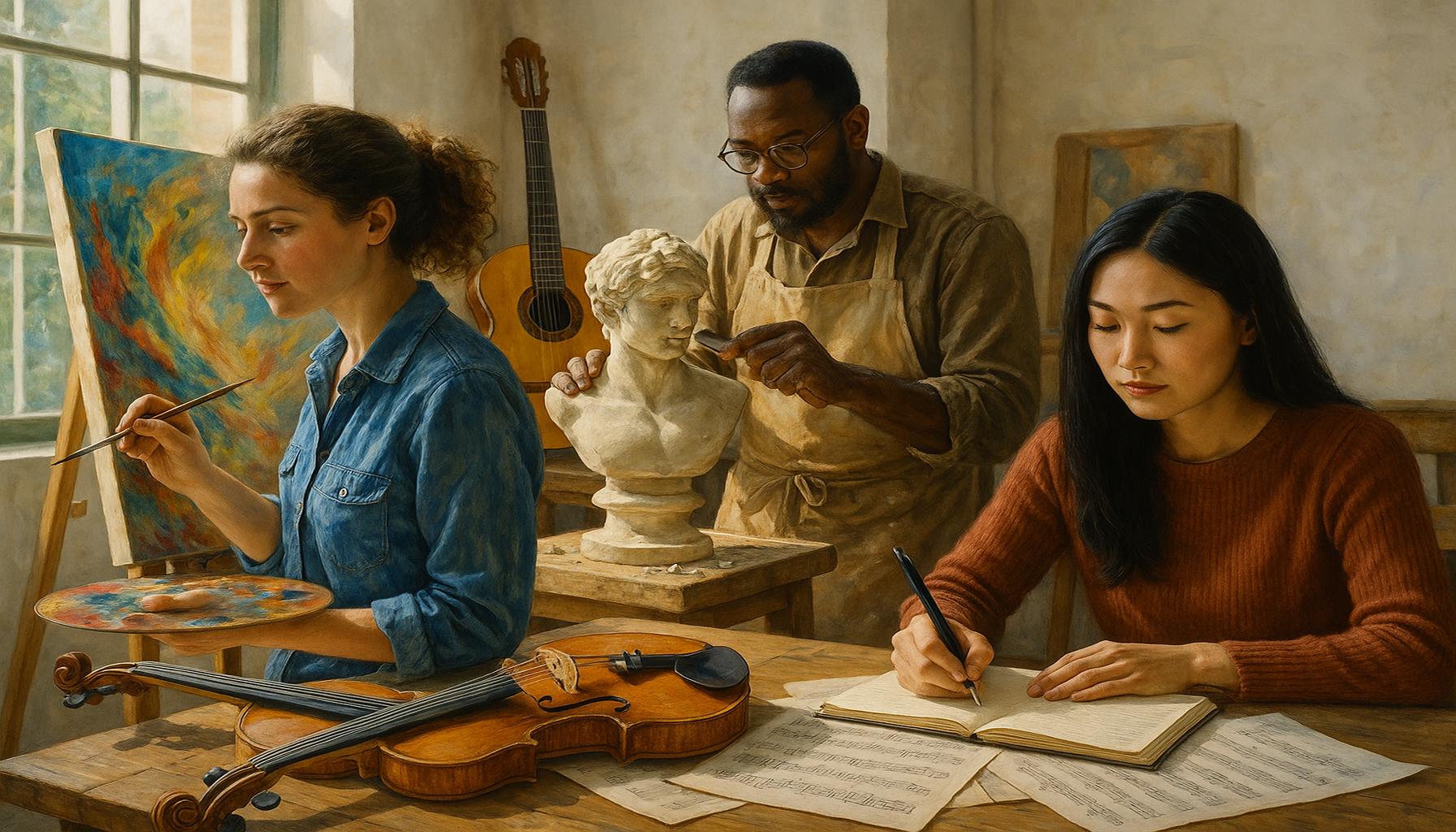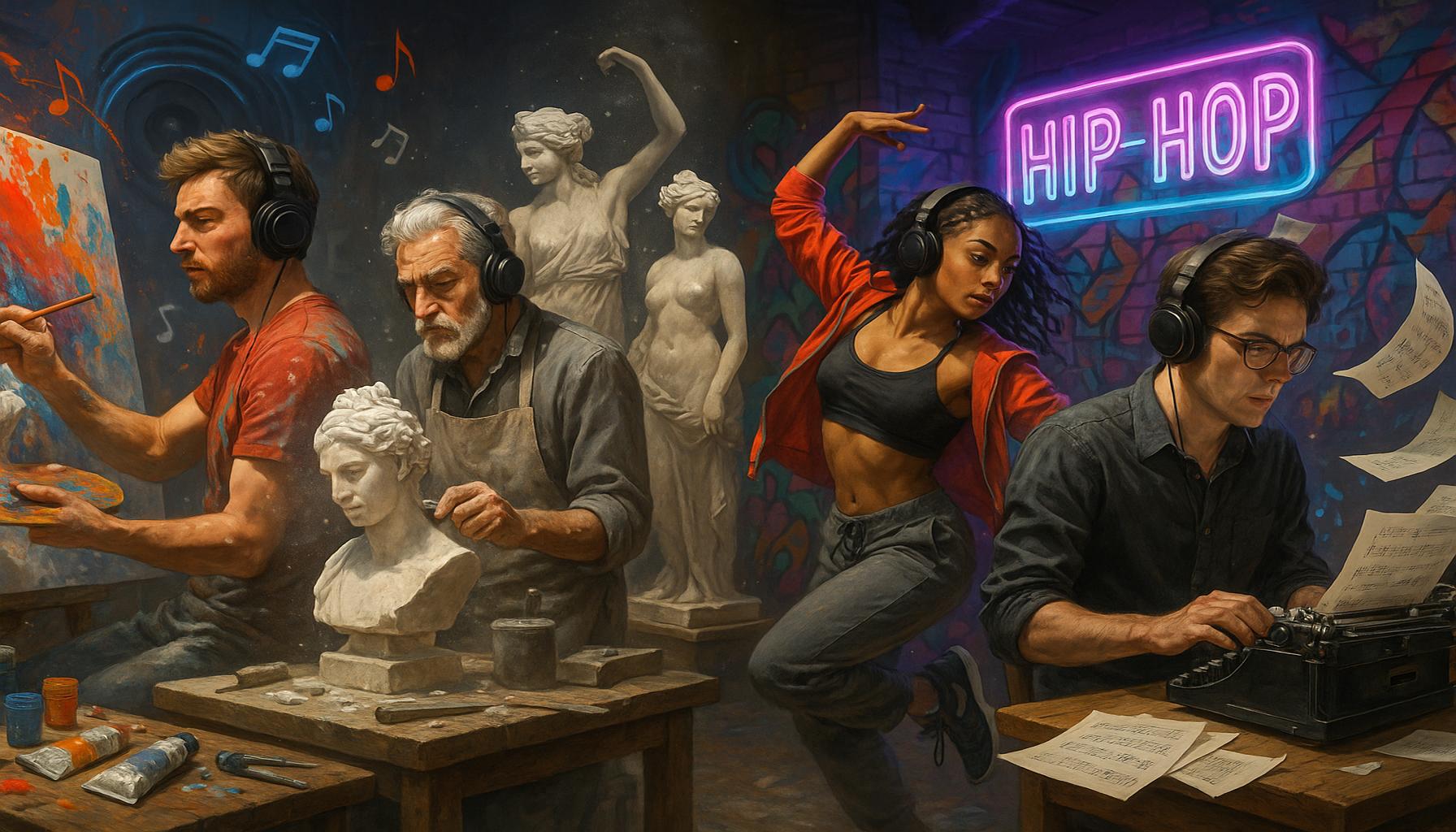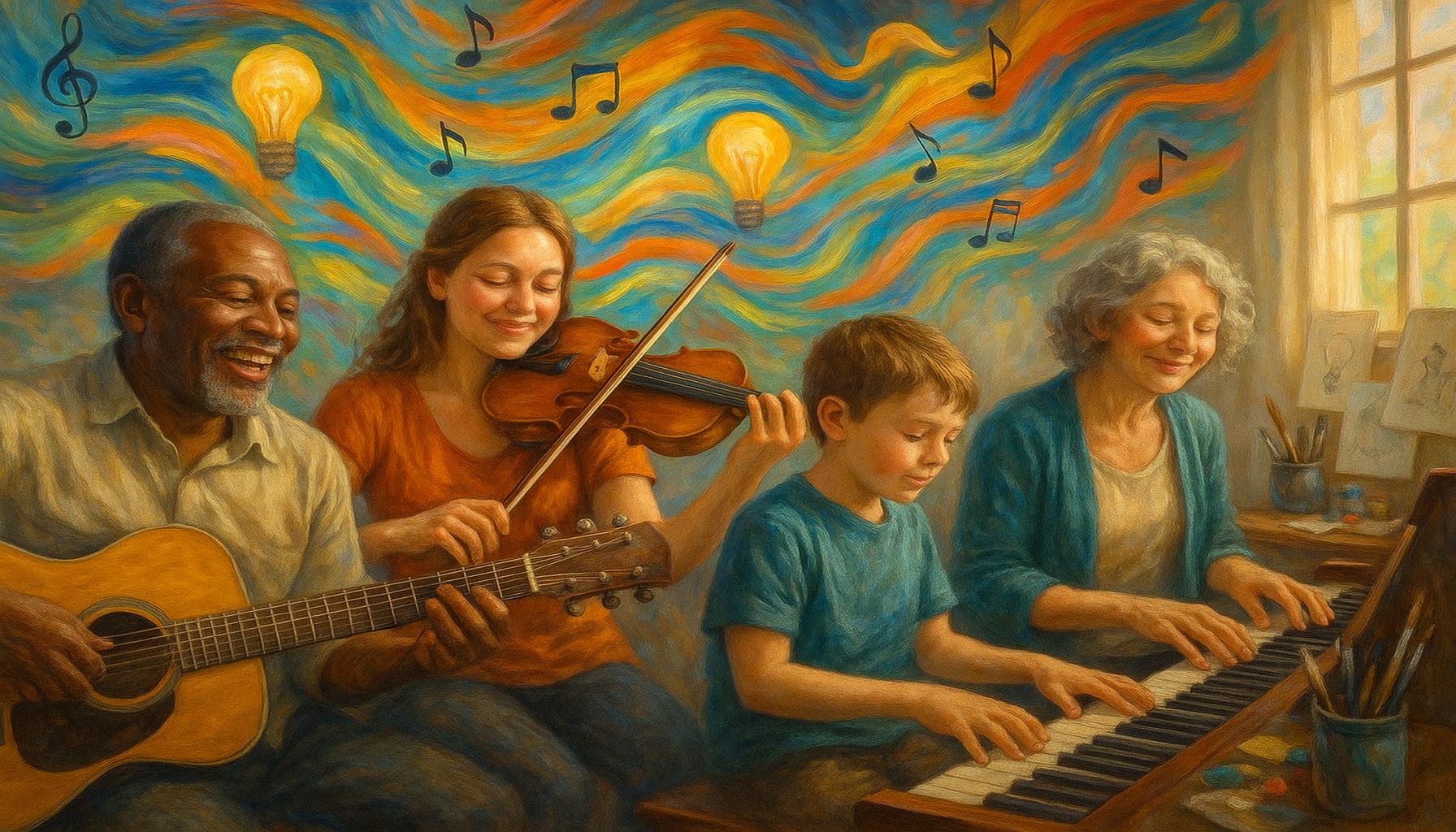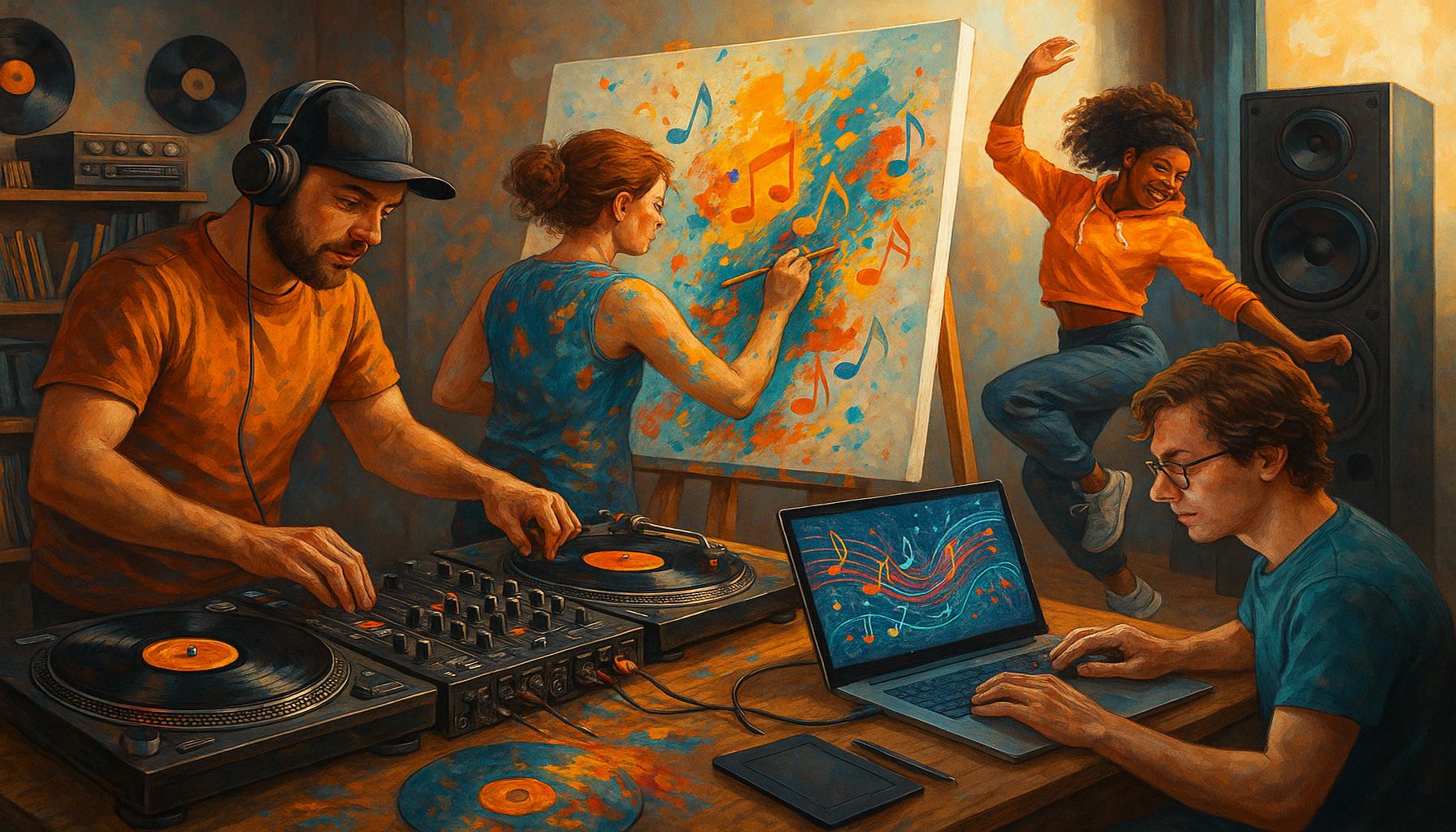The Role of Music in Inspiring Other Creative Pursuits: A Cross-Disciplinary Approach

The Impact of Music on Creative Processes
Music has long served as a powerful catalyst for creativity, intertwining with various artistic expressions and disciplines. From inspiring visual artwork to sparking innovative scientific ideas, the influence of music reaches far beyond sound waves. This interconnectedness warrants a closer look at how music can be a wellspring of inspiration across diverse fields.
Creative Expression
Artists often share their emotions and ideas through music, which can spark inspiration in other domains. For instance, the emotional depth found in compositions by artists like Beethoven or Billie Eilish can resonate deeply with painters, who might respond through vibrant brush strokes influenced by the music’s mood. The visceral nature of music can lead to the creation of visual art that captures the same emotional essence—a powerful example of this is the works of Wassily Kandinsky, who was known for creating abstract pieces inspired by his experiences with music. The interplay between rhythm and color demonstrates how auditory experiences can translate to visual expression, making the creative process profoundly interconnected.
Collaboration Across Disciplines
Musicians frequently collaborate with artists, writers, and filmmakers, resulting in rich cross-disciplinary works. Take, for instance, the partnership between musician David Bowie and director David Lynch, where their creative atmospheres influenced the aesthetics of film and stage. This collaboration not only enriched their individual projects but also created a fusion that provided audiences with new experiences, showcasing the potential of collaborative synergy. Moreover, the resurgence of musical theater in the U.S. exemplifies this collaboration, where songwriters work hand-in-hand with playwrights to create narrative-driven performances, bringing together storytelling and music in innovative ways.
Enhanced Focus and Performance
Many people use music to boost concentration, leading to improved performance in creative tasks. Studies have shown that certain types of music, such as classical or ambient sounds, can enhance cognitive functions like problem-solving and creativity. For example, a group of researchers from Stanford University found that listening to music can engage the brain in a way that encourages creative thinking. This phenomenon is particularly appealing to writers and artists who seek new ideas, often using specific playlists to cultivate the atmosphere necessary for their work.
The synergy between music and creative endeavors is indeed remarkable. Numerous creators, from renowned painters like Frida Kahlo to celebrated authors like Stephen King, have credited music as a pivotal influence in their artistic journeys. As we embark on this exploration of music’s role in inspiring other creative pursuits, we also encourage readers to reflect on their own experiences. What unique insights might arise from bridging the worlds of music and creativity? Consider how music weaves into your creative processes—whether it’s a song that motivates you during paint strokes or a melody that sparks the first lines of a novel. In doing so, we open the door to an enchanting realm where music becomes an integral part of the creative exploration experience.
DISCOVER MORE: Click here to dive into the world of upcycling
Music as a Source of Motivation and Innovation
Beyond the melodies and rhythms, music plays a crucial role in motivating individuals across various fields. For many creatives, the act of listening to music serves as a means to break through creative blocks, allowing the flow of ideas to emerge. This synergy is particularly evident in environments where brainstorming and collaboration take place. For instance, in contemporary art studios, placid soundscapes can foster a tranquil atmosphere conducive to the concentration necessary for creativity. Similarly, in tech hubs like Silicon Valley, professionals often curate playlists with upbeat and inspiring tracks to enhance their productivity and ideation processes during software development or design sessions.
The Psychological Impact of Music on Creativity
The psychological influence of music on the human brain is profound and warrants further exploration. Research suggests that engaging with music stimulates the brain’s reward pathways, releasing dopamine—a neurotransmitter associated with pleasure and motivation. This biochemical response not only enhances mood but also promotes an open-minded attitude necessary for creative thinking. In the context of creative writing, renowned authors like J.K. Rowling have shared that certain soundtracks can evoke specific emotions, assisting them in crafting compelling narratives that resonate with readers.
- Increased Emotional Resonance: Music can elicit deep emotional responses that influence storytelling and visual interpretations.
- Enhanced Brain Functionality: Listeners may experience more effective problem-solving and innovative thinking.
- Improved Workflow: Many creatives utilize music to set the pace for their work, enabling a more productive environment.
Collaborative efforts also illuminate the unique connection between music and other artistic pursuits. The integration of musical elements in different forms of expression, such as dance and theater, illustrates how music can transform a seemingly mundane experience into an emotive journey. A compelling example of this can be found in the works of choreographers like Martha Graham, who seamlessly intertwined music with dance, using the rhythms and beats to inspire movements that tell a story. This sublime marriage between sound and motion not only captivates audiences but also encourages dancers to push the boundaries of their physical expression.
Music and Innovation in Science and Technology
The influence of music extends even into the realms of science and technology, becoming a source of inspiration for groundbreaking innovations. Scientists often cite music as a muse that prompts unexpected ideas. For instance, the famous physicist Albert Einstein played the violin, finding solace in music while pondering complex theories. This coupling of music and scientific endeavor illustrates how the creative process transcends walls between disciplines, leading to remarkable discoveries. Whether in the rhythm of an experiment or the melodies of brainstorming sessions, music provides a backdrop that nurtures intellectual curiosity and innovation.
As we begin to explore the role of music in inspiring creative pursuits, it becomes increasingly clear that its impact is both profound and multifaceted. The interplay between music, emotion, and innovation reveals a dynamic landscape where creativity knows no bounds. How do you personally experience the inspiration of music in your own creative ventures? The answers may unlock new dimensions within your artistic journey.
| Creative Pursuits | Influential Role of Music |
|---|---|
| Visual Arts | Music provides rhythm and emotion, enhancing the creativity and expressiveness of artists. |
| Literature | Musical themes inspire narrative structures and character development, creating deeper emotional connections. |
| Dance | Musicians and dancers collaborate, where sound informs movement and creates a dynamic interaction. |
| Film | A powerful soundtrack can elevate storytelling, bringing deeper emotional resonance to visual narratives. |
| Theater | Music shapes the atmosphere and portrays complex emotions, enhancing dramatic performances. |
In exploring the intersection of music and various creative disciplines, it becomes clear that music not only serves as a backdrop but as an impetus for innovation across fields. The synergy between music and visual arts, literature, dance, film, and theater showcases how musical elements influence creative processes. For instance, artists frequently find inspiration in rhythms and melodies, translating auditory sensations into vibrant colors and strokes on canvases. Literature, on the other hand, benefits from musical theories that inform structure, enhancing storytelling depth. Additionally, in dance, the interplay between sound and movement creates a dialogue that enhances expression. Similarly, film scores emphasize pivotal moments, solidifying the emotional impact of scenes. This cross-disciplinary exploration highlights the transformative power of music in igniting creativity, inviting audiences to investigate these dynamic relationships further.
DISCOVER MORE: Click here to learn about the evolution of digital art
The Transformative Power of Music in Education and Learning
Music not only inspires creativity but also serves as a powerful educational tool. In classrooms across the United States, educators have begun to recognize the potential of incorporating music into their teaching methodologies. Music education has been shown to enhance cognitive development, improve memory retention, and facilitate better communication skills. Programs such as the “El Sistema” initiative in Venezuela and similar projects in U.S. inner cities emphasize the importance of music education in nurturing creative talents while also equipping students with valuable life skills.
Motivational Techniques and Their Impact on Learning
Utilizing music within academic settings creates an engaging and dynamic learning environment. Studies indicate that students who listen to classical music or calming soundscapes during study sessions show improved concentration and greater retention of information. Research from the University of California, Irvine, has highlighted a phenomenon known as the “Mozart Effect,” where short-term listening to classical tracks has been linked to enhanced abstract reasoning. This effect isn’t limited to traditional academic subjects; it extends to creative disciplines like art and theater as well.
- Creativity in STEM Fields: Incorporating music into STEM education fosters innovative thinking, as students learn to approach problems from multiple angles.
- Improvement in Engagement: Music-infused lessons capture students’ attention, making learning more enjoyable and reducing classroom distractions.
- Critical Thinking Enhancement: Debates surrounding musical interpretation allow students to develop their critical thinking and analytical skills, vital for interdisciplinary work.
Moreover, the influence of music can be potent when it comes to fostering collaboration in educational environments. Group activities that involve music—such as rhythmic exercises or collaborative songwriting—cultivate teamwork and build a sense of community. Such methods enable learners to appreciate diverse viewpoints while promoting a collective creative effort that transcends individual limitations. This collaborative learning mirrors the cooperative spirit found in various artistic fields, where musicians, dancers, and visual artists come together to create a unified expression of creativity.
The Role of Music in Therapeutic and Healing Practices
Beyond formal education, music has significant implications in therapeutic environments, underlining its role in inspiring creative pursuits. Music therapy, an established field, employs music as a treatment modality to enhance emotional health, assist with rehabilitation, and promote personal growth. Practitioners utilize various musical techniques to tap into patients’ emotions, fostering self-expression and healing. Studies show that music therapy can help reduce anxiety and depression and improve cognitive function in patients with neurodegenerative diseases, providing a vibrant avenue for artistic exploration even amid challenges.
Through this lens, it becomes evident that music is not simply a source of enjoyment but a catalyst for creative exploration across multiple domains. Whether in educational settings, collaborative projects, or healing practices, the transformative power of music continues to inspire inquiry, innovation, and discovery. As more individuals engage with music in these various contexts, the relationship between sound and creative expression will likely evolve, revealing new facets of artistic potential waiting to be explored.
DISCOVER MORE: Click here for effective techniques
Conclusion: The Unifying Influence of Music Across Creative Disciplines
In summary, the multifaceted role of music as an inspiring force cannot be overstated. From enhancing cognitive abilities in educational environments to acting as a therapeutic medium that fosters emotional healing, music permeates various aspects of life and creativity. By bridging gaps between disciplines such as STEM, the arts, and therapy, music cultivates not only creative skills but also essential life competencies. The innovative integration of music into educational frameworks engages students and enhances their learning experience, while initiatives like music therapy underscore its profound impact on personal growth and emotional well-being.
As we continue to explore the intersection of music with other creative pursuits, it is vital to employ a cross-disciplinary approach that recognizes the potential of music to inspire divergent thinking and collaborative efforts. Future generations can benefit from a more cohesive educational model that intertwines music with various subjects, encouraging a holistic learning experience that effectively nourishes creativity. With ongoing research and experiential evidence supporting these claims, the possibilities for a more integrated and innovative creative landscape appear boundless.
In essence, music serves as a vital thread that connects diverse disciplines, inspiring individuals to transcend conventional boundaries and explore their artistic potential. As we embrace the power of music in all its forms, we take a significant step toward fostering a richer, more creative society, poised for exploration and innovation in every field.


